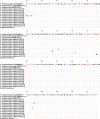High prevalence of Pentatrichomonas hominis infection in gastrointestinal cancer patients
- PMID: 31462294
- PMCID: PMC6714378
- DOI: 10.1186/s13071-019-3684-4
High prevalence of Pentatrichomonas hominis infection in gastrointestinal cancer patients
Abstract
Background: Pentatrichomonas hominis is a flagellated protozoan that inhabits the large intestine of humans. Although several protozoans have been proposed to have a role in cancer progression, little is known about the epidemiology of P. hominis infection in cancer patients.
Methods: To determine the prevalence of P. hominis in patients with digestive system malignancies, we collected 195 and 142 fecal samples from gastrointestinal cancer patients and residents without any complaints related to the digestive system, respectively. Each sample was detected for the presence of P. hominis by nested PCR amplifying the internal transcribed spacer (ITS) region and partial 18S rRNA gene.
Results: A significantly higher prevalence of P. hominis was found in cancer patients than that in the control population (41.54 vs 9.15%, χ2 = 42.84, df = 1, P < 0.001), resulting in a 6.75-fold risk of gastrointestinal cancers (OR: 6.75, 95% CI: 3.55-12.83, P < 0.001). The highest prevalence of P. hominis infection was detected in small intestine cancer patients (60%, OR: 14.88, 95% CI: 0.82-4.58, P = 0.009) followed by liver (57.14%, χ2 = 10.82, df = 1, P = 0.001) and stomach cancer patients (45.1%, χ2 = 31.95, df = 1, P < 0.001). In addition, phylogenetic analysis provided some evidence supporting that human P. hominis infection might derive from animal sources.
Conclusions: To our knowledge, this study is the first report presenting the high association between P. hominis and gastrointestinal cancers. Nevertheless, whether there is any possible pathological role of P. hominis infection in cancer patients needs to be further elucidated.
Keywords: Colorectal cancer; Epidemiology; Gastrointestinal cancer; Pentatrichomonas hominis; Stomach cancer.
Conflict of interest statement
The authors declare that they have no competing interests.
Figures



References
-
- American Cancer Society . Cancer facts and figures 2018. Atlanta: American Cancer Society; 2018.
MeSH terms
Substances
Grants and funding
LinkOut - more resources
Full Text Sources
Miscellaneous

